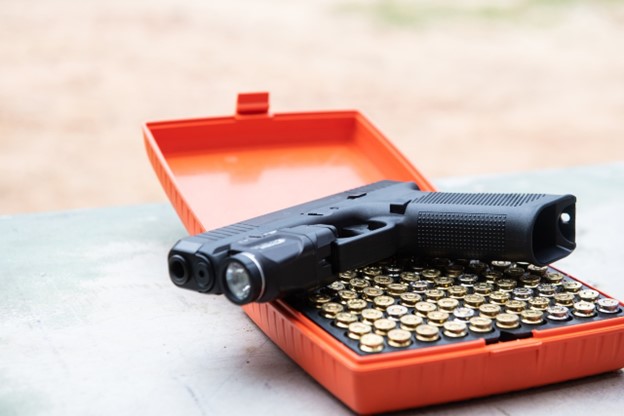When it comes to getting into shooting or firearm hobbies, the first and most important thing beginners need to do is familiarize themselves with basic gun safety rules and principles. While many of the most common gun safety rules might seem obvious to people, they always warrant reiteration, as one slip-up with firearm safety can be catastrophic. Beginners in particular need to strictly adhere to these rules and frequently remind themselves of them until they become second nature. To understand the extreme importance of this, it warrants briefly going over ten of the most fundamental gun safety rules and why they’re so important.
Treat Every Gun as If it’s Loaded
This is one of the most frequently reiterated rules regarding gun safety and for good reason. Though this is a seemingly simple rule that one might think only applies to novices, this is not the case – even experienced gun enthusiasts strictly adhere to this rule. Treating a gun as if it’s loaded even if one is a hundred percent sure it’s not is important because it cultivates a mindset that prevents accidental discharges.
Keep Your Finger Off the Trigger Until Your Read to Shoot
This is another rule that might seem obvious, but nonetheless must be stringently followed. If your finger is on the trigger, the risk of accidental discharge is much higher than if your finger is off of it. There are so many potential ways one could accidentally pull the trigger; a fall, a muscle twitch, or a simple underestimation of force being applied to the trigger could all lead to accidental discharge and could be avoided by simply keeping one’s finger off of the trigger.
Point the Muzzle in a Safe Direction
One should always make sure that the muzzle of their firearm is pointed in a safe direction or at the intended target. Again, this is another rule that helps formulate a good habit and mindset that mitigates the risk of injury or death in the case of an accidental discharge.
Be Aware of Your Target and What’s Beyond It
Know what you’re shooting at! For instance, one should be wary of shooting certain objects that could lead to ricochet or triggering explosive material. On top of this, you should always take the time to consider what is beyond or behind your target. Bullets often travel through targets, even piercing through walls, and there could be objects or people beyond them. It’s important to be aware of pertinent factors such as the firearm and ammo being used as certain firearms or ammo might have more or less penetrative depth.
Understand How Your Gun Works
Before using any gun, make sure you know how it works and how you can safely handle it. This includes understanding how to load, unload, and safely handle the weapon. Also, if available, you should always take the time to be aware of the safety mechanisms on a firearm, and use them appropriately.
Use the Correct Ammunition
You should always make sure to use the proper specified ammunition recommended for a firearm. Incorrect ammunition can cause malfunctions in the firearm or worse, can lead to accidental misfires or even catastrophic failures such as the explosion of the firearm.
Inspect and Maintain Your Firearm
Routine inspection and maintenance is an essential safety practice and better ensures safe, proper firearm function. Clean your gun to make sure that things such as dirt, rust, or other forms of debris don’t compromise its functionality. This is extremely important as an improperly maintained firearm is much more likely to misfire, jam or even explode due to mechanical failure. A malfunctioning gun is always a dangerous gun! It’s worth investing in proper cleaning equipment.
Unload Firearms When Not in Use

Immediately after a shooting session, make sure that your firearm is fully unloaded. This is another safety protocol that mitigates the risk of accidental discharges and ensures safe handling when the gun isn’t being used. Even if you’re taking a break during a shooting session, unloading the gun beforehand is a great safety habit to develop.
Store Firearms Safely
When your firearms are not in use, they should always be safely locked away and preferably unloaded. This is especially the case given that firearms are often the target of theft and many firearm related injuries stem from inexperienced gun handlers, such as children, playing around with a loaded firearm. You can easily acquire tools such as a gunlock, safe, or numerous other storage options from your local gun shop to prevent unauthorized access and keep everyone safe.
Wear Eye and Ear Protection
Shooting firearms is often extremely loud and there is the potential for debris, ejections, or ricocheted material to fly into one’s eyes. Protective ear and eye gear mitigates the risk of hearing loss and damage to one’s eyes, especially if you plan to regularly go shooting.
Making Gun Safety Second Nature
Again, some of these rules might seem obnoxiously self-evident, but they must be practiced and reflected on until they become reflexive habits. Each rule functions as a critical safeguard, working in tandem with the others to create several layers of protection. Mastering these principles ensures the mitigation of potential calamity. Proper gun safety goes beyond merely knowing the rules – it’s about ingraining them into behavior such that they’re second nature!
Latest posts by Tactical Gun Review (see all)
- Bow hunting – an unforgettable experience – April 24, 2025
- Is MagnaCut the Next Breakthrough in Knife Steel? – December 17, 2024
- The Importance of Proper Gun Cleaning and Maintenance – October 30, 2024

Leave a Reply